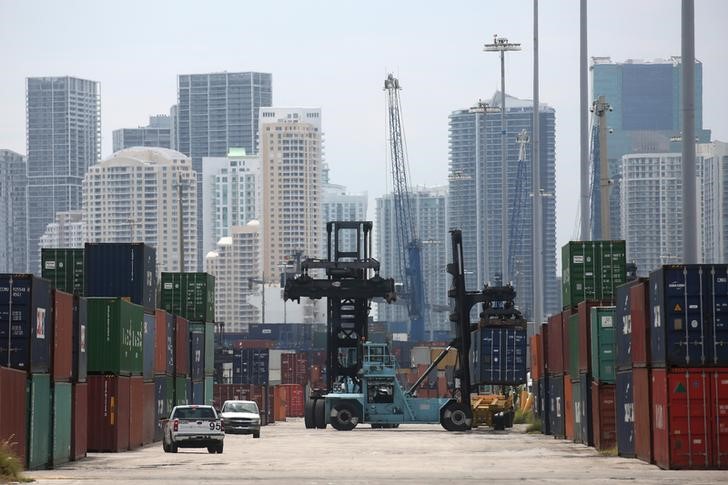Image: A mule truck moves a container in the Port of Miami in Miami, Florida, U.S., May 19, 2016. REUTERS/Carlo Allegri
By Lucia Mutikani
WASHINGTON (Reuters) – The U.S. trade deficit jumped to a near five-year high in January as rising oil prices helped to push up the import bill, pointing to slower economic growth in the first quarter and posing a challenge for the Trump administration.
President Donald Trump took office with a pledge to boost annual economic growth to 4 percent and renegotiate trade deals in favor of the United States. Trump blames U.S. trade policy for the loss of American factory jobs and the import-driven surge in the trade gap could intensify the debate on a cross-border tax.
“Team Trump really has their work cut out for them if they are going to stick with the campaign pledge to double growth,” said Chris Rupkey, chief economist at MUFG in New York. “If it is not made in America then we don’t want it is what the Trump administration is saying.”
The Commerce Department said on Tuesday the trade gap increased 9.6 percent to $48.5 billion, also buoyed by imports of cell phones and automobiles. That was the highest level since March 2012. When adjusted for inflation, the trade deficit rose to $65.3 billion from $62.0 billion in December.
Both the inflation-adjusted imports and exports were the highest on record in January, signs of improving domestic demand and stronger economic growth among U.S. trading partners. Nevertheless, the wider trade deficit suggests trade could again weigh on economic growth in the first quarter.
Data such as housing starts, consumer spending and construction outlays have implied the economy struggled to regain momentum early in the first quarter after growth slowed to a 1.9 percent annualized rate in the final three months of 2016.
Trade cut 1.7 percentage points from gross domestic product in the fourth quarter. Following the trade data, the Atlanta Federal Reserve slashed its first-quarter GDP estimate by five-tenths of a percentage point to a 1.3 percent rate.
The economy grew at a 3.5 percent pace in the third quarter.
The dollar was trading little changed against a basket of currencies, while prices for U.S. government bonds slipped. U.S. stocks fell as healthcare stocks took a beating after Trump tweeted about lowering drug prices.
MUCH WORK TO DO
Commerce Secretary Wilbur Ross said the January trade data showed there was “much” work to be done.
“In the coming months we will renegotiate bad trade deals and bring renewed energy to trade enforcement in defense of all hard-working Americans,” Ross said.
The administration has pulled out of the 12-nation Trans-Pacific Partnership trade pact. Trump also wants to renegotiate the North American Free Trade Agreement (NAFTA), which was signed in 1994 by the United States, Canada and Mexico.
Economists, however, warn that the America-first or protectionist policies being pursued by the administration are a threat to the country’s economic health as other nations could retaliate. Reports last week suggested the government was preparing to ignore any rulings by the World Trade Organization it sees as an affront to U.S. sovereignty.
“If the U.S. carries through with its threats not to heed WTO rulings, it will encourage other countries to defect from the international free-trade regime and increase the risks of beggar-thy-neighbor policies,” said Marc Chandler, global currency strategy head at Brown Brothers Harriman in New York.
In January, imports of goods and services increased 2.3 percent to $240.6 billion, the highest since December 2014, as the country imported 259 million barrels of crude oil. That was the largest amount since July 2013.
The price of imported oil averaged $43.94 per barrel in January, the highest since August 2015. That pushed the value of petroleum imports to a two-year high. Imports of cell phones and other household goods rose $1.0 billion, while those of automobiles hit a record high.
There were also strong gains in imports of industrial supplies and materials, and capital goods. China accounted for the bulk of imports, sending $41.4 billion worth of merchandise. That was up 5.1 percent from December.
Exports of goods and services climbed 0.6 percent to $192.1 billion, the highest level since December 2014. They were supported by shipments of industrial supplies and materials, which hit their highest level in two years. Petroleum exports were the highest since May 2015.
Exports to China dropped 13.4 percent, leaving the politically sensitive U.S.-China trade deficit up 12.8 percent at $31.3 billion. The nation’s trade deficit with Mexico fell 10.1 percent to its lowest level since July 2015.
(Reporting By Lucia Mutikani; Editing by Andrea Ricci)
Copyright 2017 Thomson Reuters. Click for Restrictions.


